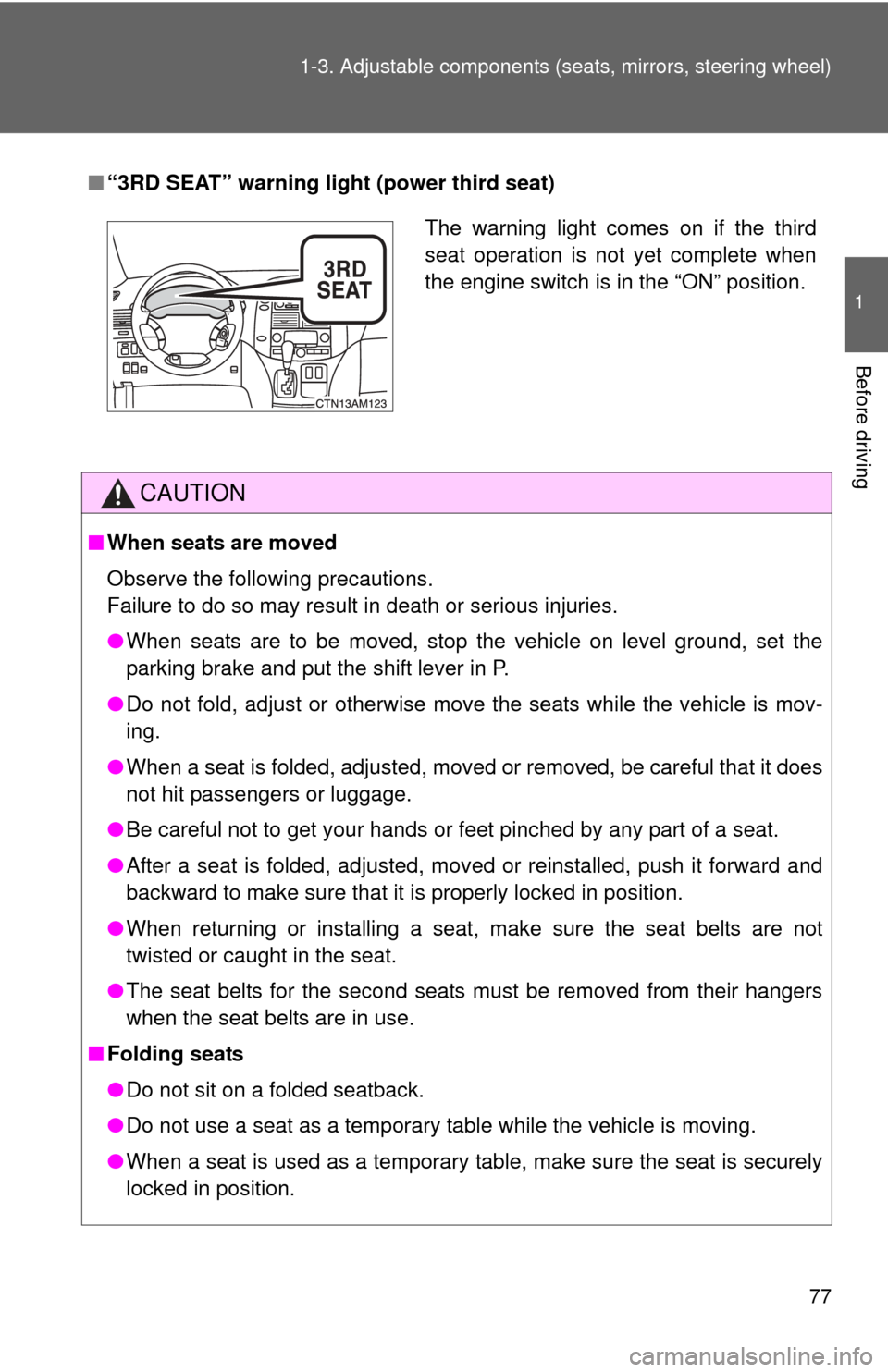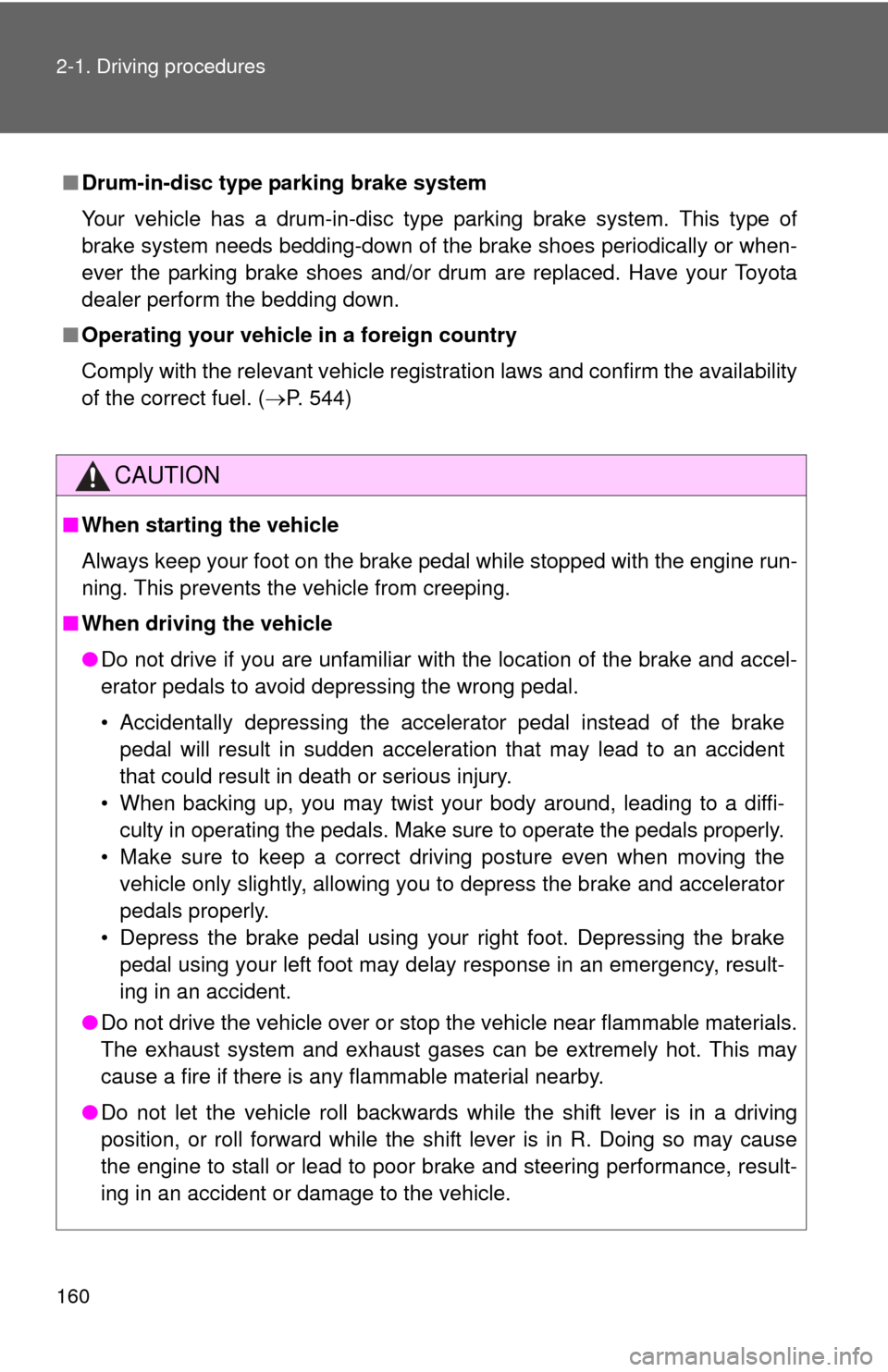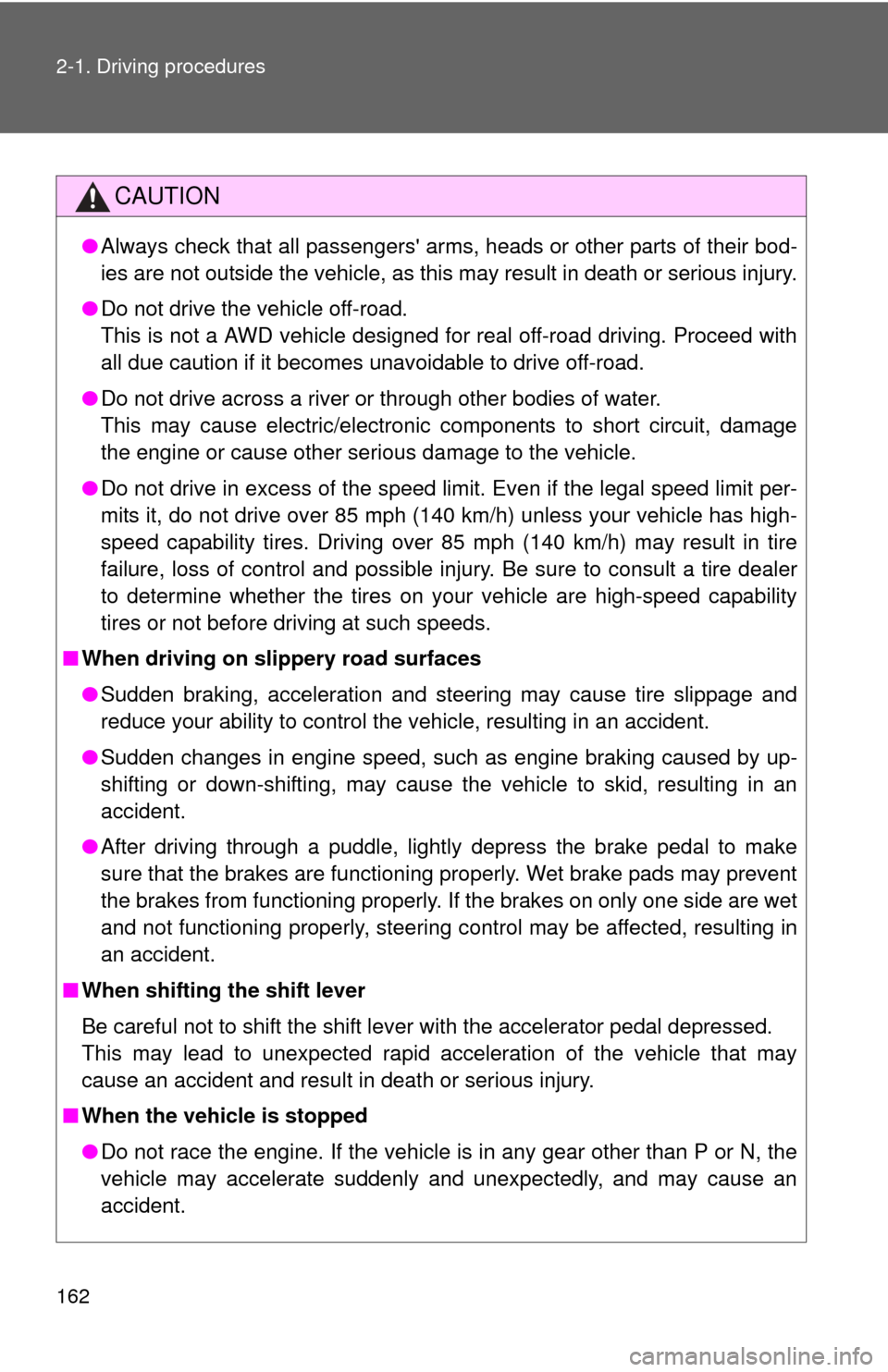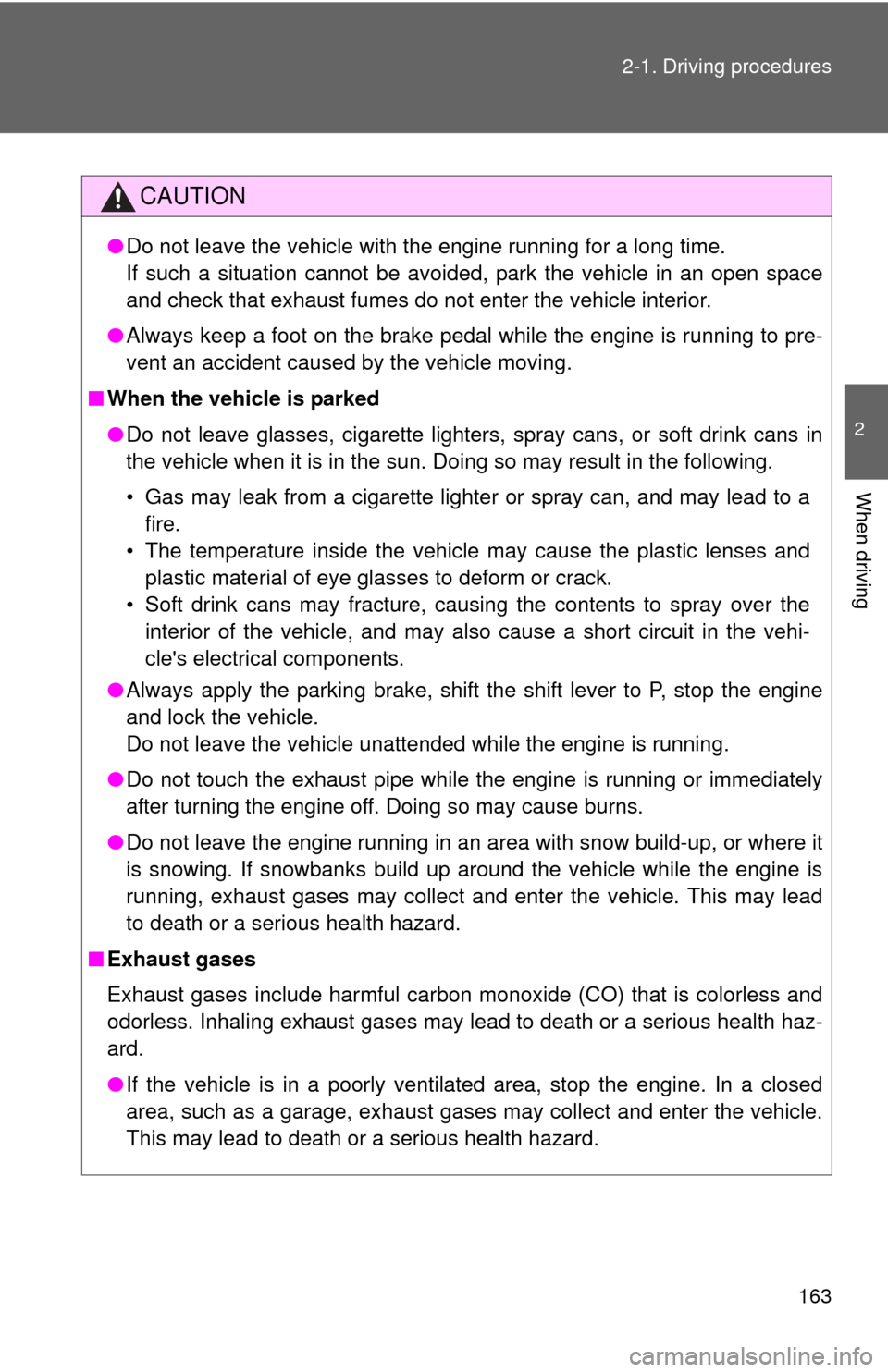2010 TOYOTA SIENNA brake light
[x] Cancel search: brake lightPage 2 of 592

TABLE OF CONTENTSIndex
2
1-1. Key informationKeys ..................................... 26
1-2. Opening, closing
and
locking the
doors
Wireless remote control ....... 27
Front doors ........................... 33
Sliding doors ........................ 37
Back door ............................. 47
1-3.
Adjustable components
(seats, mirrors,
steering wheel)
Front seats
........................... 56
Second seats ....................... 59
Third seats ........................... 61
Seating configurations.......... 63
Driving position memory....... 80
Head restraints ..................... 82
Seat belts ............................. 85
Steering wheel ..................... 94
Anti-glare inside rear view mirror .................................. 95
Outside rear view mirrors ..... 97
1-4. Opening a
nd closing the
windo
ws
Power windows .................. 100
Quarter windows ................ 102
Moon roof ........................... 104
1-5. Refueling Opening the fuel tank cap ................................... 107 1-6. Theft deterrent system
Engine immobilizer system .............................. 111
Alarm .................................. 113
Theft prevention labels (for U.S.A.) ....................... 115
1-7. Safety information Correct driving posture ....... 116
SRS airbags ....................... 118
Front passenger occupant classification system ......... 130
Child restraint systems ....... 136
Installing child restraints ..... 140
2-1. Driving procedures Driving the vehicle .............. 158
Engine (ignition) switch....... 167
Automatic transmission ...... 170
Turn signal lever ................. 172
Parking brake ..................... 173
2-2. Instrument c
luster and
information display
Gauges and meters
............ 174
Indicators and warning lights ................................. 177
Trip information display ...... 181
2-3. Operating the li
ghts and
wipers
Headlight switch
................. 185
Fog light switch ................... 190
1Before driving
2When driving
Page 14 of 592

14
Tilt and telescopic
steering lock release
lever
P. 94
Pictorial index
Headlight switch
Turn signal lever
Fog light switch
P. 185
P. 172
P. 190
Instrument panel
Glove box P. 365
Windshield wiper and
washer switch
Rear window wiper and
washer switch
P. 191
P. 193
Auxiliary box P. 375
Power outlets P. 387
Fuel filler door opener P. 107
Gauges and meters P. 174
TRAC off switch P. 216
Cup holder
Coin holder P. 370
P. 369
Auxiliary box P. 375
Parking brake pedal P. 173
Bottle holders P. 374
Hood release lever P. 434
Page 77 of 592

77
1-3. Adjustable components (s
eats, mirrors, steering wheel)
1
Before driving
■“3RD SEAT” warning light (power third seat)
CAUTION
■When seats are moved
Observe the following precautions.
Failure to do so may result in death or serious injuries.
●When seats are to be moved, stop the vehicle on level ground, set the
parking brake and put the shift lever in P.
● Do not fold, adjust or otherwise move the seats while the vehicle is mov-
ing.
● When a seat is folded, adjusted, moved or removed, be careful that it does
not hit passengers or luggage.
● Be careful not to get your hands or feet pinched by any part of a seat.
● After a seat is folded, adjusted, moved or reinstalled, push it forward and
backward to make sure that it is properly locked in position.
● When returning or installing a seat, make sure the seat belts are not
twisted or caught in the seat.
● The seat belts for the second seats must be removed from their hangers
when the seat belts are in use.
■ Folding seats
●Do not sit on a folded seatback.
● Do not use a seat as a temporary table while the vehicle is moving.
● When a seat is used as a temporary table, make sure the seat is securely
locked in position.
The warning light comes on if the third
seat operation is not yet complete when
the engine switch is in the “ON” position.
Page 157 of 592

When driving2
157
2-1. Driving proceduresDriving the vehicle............ 158
Engine (ignition) switch .... 167
Automatic transmission .... 170
Turn signal lever .............. 172
Parking brake ................... 173
2-2. Instrument cluster and information display
Gauges and meters ......... 174
Indicators and warning lights .............................. 177
Trip information display .... 181 2-3. Operating the lights and
wipers
Headlight switch ............... 185
Fog light switch ................ 190
Windshield wipers and washer ........................... 191
Rear window wiper and washer ........................... 193
2-4. Using other driving systems Cruise control ................... 194
Dynamic laser cruise control ............................ 197
Intuitive parking assist...... 209
Driving assist systems ..... 215
2-5. Driving information Cargo and luggage .......... 219
Vehicle load limits ............ 225
Winter driving tips ............ 226
Trailer towing ................... 229
Dinghy towing .................. 237
Page 160 of 592

160 2-1. Driving procedures
■Drum-in-disc type parking brake system
Your vehicle has a drum-in-disc type parking brake system. This type of
brake system needs bedding-down of the brake shoes periodically or when-
ever the parking brake shoes and/or drum are replaced. Have your Toyota
dealer perform the bedding down.
■ Operating your vehicle in a foreign country
Comply with the relevant vehicle registration laws and confirm the availability
of the correct fuel. ( P. 544)
CAUTION
■When starting the vehicle
Always keep your foot on the brake pedal while stopped with the engine run-
ning. This prevents the vehicle from creeping.
■ When driving the vehicle
●Do not drive if you are unfamiliar with the location of the brake and accel-
erator pedals to avoid depressing the wrong pedal.
• Accidentally depressing the accelerator pedal instead of the brake
pedal will result in sudden acceleration that may lead to an accident
that could result in death or serious injury.
• When backing up, you may twist your body around, leading to a diffi- culty in operating the pedals. Make sure to operate the pedals properly.
• Make sure to keep a correct driving posture even when moving the vehicle only slightly, allowing you to depress the brake and accelerator
pedals properly.
• Depress the brake pedal using your right foot. Depressing the brake pedal using your left foot may delay response in an emergency, result-
ing in an accident.
● Do not drive the vehicle over or st op the vehicle near flammable materials.
The exhaust system and exhaust gases can be extremely hot. This may
cause a fire if there is any flammable material nearby.
● Do not let the vehicle roll backwards while the shift lever is in a driving
position, or roll forward while the shift lever is in R. Doing so may cause
the engine to stall or lead to poor brake and steering performance, result-
ing in an accident or damage to the vehicle.
Page 162 of 592

162 2-1. Driving procedures
CAUTION
●Always check that all passengers' arms, heads or other parts of their bod-
ies are not outside the vehicle, as this may result in death or serious injury.
● Do not drive the vehicle off-road.
This is not a AWD vehicle designed for real off-road driving. Proceed with
all due caution if it becomes unavoidable to drive off-road.
● Do not drive across a river or through other bodies of water.
This may cause electric/electronic components to short circuit, damage
the engine or cause other serious damage to the vehicle.
● Do not drive in excess of the speed limit. Even if the legal speed limit per-
mits it, do not drive over 85 mph (140 km/h) unless your vehicle has high-
speed capability tires. Driving over 85 mph (140 km/h) may result in tire
failure, loss of control and possible injury. Be sure to consult a tire dealer
to determine whether the tires on your vehicle are high-speed capability
tires or not before driving at such speeds.
■ When driving on slippery road surfaces
●Sudden braking, acceleration and steering may cause tire slippage and
reduce your ability to control the vehicle, resulting in an accident.
● Sudden changes in engine speed, such as engine braking caused by up-
shifting or down-shifting, may cause the vehicle to skid, resulting in an
accident.
● After driving through a puddle, lightly depress the brake pedal to make
sure that the brakes are functioning properly. Wet brake pads may prevent
the brakes from functioning properly. If the brakes on only one side are wet
and not functioning properly, steering control may be affected, resulting in
an accident.
■ When shifting the shift lever
Be careful not to shift the shift lever with the accelerator pedal depressed.
This may lead to unexpected rapid acceleration of the vehicle that may
cause an accident and result in death or serious injury.
■ When the vehicle is stopped
●Do not race the engine. If the vehicle is in any gear other than P or N, the
vehicle may accelerate suddenly and unexpectedly, and may cause an
accident.
Page 163 of 592

163
2-1. Driving procedures
2
When driving
CAUTION
●
Do not leave the vehicle with the engine running for a long time.
If such a situation cannot be avoided, park the vehicle in an open space
and check that exhaust fumes do not enter the vehicle interior.
● Always keep a foot on the brake pedal while the engine is running to pre-
vent an accident caused by the vehicle moving.
■ When the vehicle is parked
●Do not leave glasses, cigarette lighters, spray cans, or soft drink cans in
the vehicle when it is in the sun. Doing so may result in the following.\
• Gas may leak from a cigarette lighter or spray can, and may lead to a
fire.
• The temperature inside the vehicle may cause the plastic lenses and plastic material of eye glasses to deform or crack.
• Soft drink cans may fracture, causing the contents to spray over the interior of the vehicle, and may also cause a short circuit in the vehi-
cle's electrical components.
● Always apply the parking brake, shift the shift lever to P, stop the engine
and lock the vehicle.
Do not leave the vehicle unattended while the engine is running.
● Do not touch the exhaust pipe while the engine is running or immediately
after turning the engine off. Doing so may cause burns.
● Do not leave the engine running in an area with snow build-up, or where it
is snowing. If snowbanks build up around the vehicle while the engine is
running, exhaust gases may collect and enter the vehicle. This may lead
to death or a serious health hazard.
■ Exhaust gases
Exhaust gases include harmful carbon monoxide (CO) that is colorless and
odorless. Inhaling exhaust gases may lead to death or a serious health haz-
ard.
●If the vehicle is in a poorly ventilated area, stop the engine. In a closed
area, such as a garage, exhaust gases may collect and enter the vehicle.
This may lead to death or a serious health hazard.
Page 188 of 592

188 2-3. Operating the lights and wipers
■Daytime running light system (if equipped)
To make your vehicle more visible to other drivers, the headlights turn on
automatically (at a reduced intensity) whenever the engine is started and the
parking brake is released. Daytime running lights are not designed for use at
night.
■ Headlight control sensor (if equipped)
■ Automatic light off system
●When the light switch is in the
or position with the tail
lights on: The tail lights turn off after driver’s door is opened if the engine
switch has been turned to the “ACC” or “LOCK” position.
● When the light switch is in the or position with the head-
lights on: The headlights and all lights turn off 30 seconds after all the
side doors and back door are closed if the engine switch has been turned
to the “ACC” or “LOCK” position. (The lights turn off immediately if the
on the wireless remote control is pressed after all doors are
locked.)
To turn the lights on again, turn the engine switch to the “ON” position, or
turn the light switch off once and then back to the
or position.
■ Customization that can be co nfigured at Toyota dealer
Settings (e.g. light sensor sensitivity) can be changed.
(Customizable features P. 565)
The sensor may not function properly if
an object is placed on the sensor, or any-
thing that blocks the sensor is affixed to
the windshield.
Doing so interferes with the sensor
detecting the level of ambient light and
may cause the automatic headlight sys-
tem to malfunction.